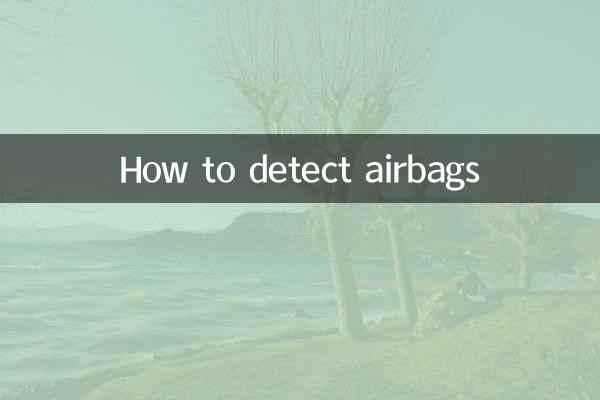How to Detect Airbags: A Comprehensive Guide and Analysis of Recent Hot Topics
Airbags are a vital component of vehicle safety systems and can effectively protect passengers in the event of an accident. However, many car owners know little about how to detect the status of airbags. This article will combine hot topics in the past 10 days to provide you with a detailed testing guide and attach relevant data for reference.
1. Analysis of the relationship between recent hot topics and airbags

In the past 10 days, discussions on vehicle safety across the Internet have mainly focused on the following hot spots (data as of October 2023):
| Ranking | hot topics | Relevance | Number of discussions (10,000) |
|---|---|---|---|
| 1 | New energy vehicle safety controversy | high | 320 |
| 2 | Used car inspection traps | Middle to high | 180 |
| 3 | Airbag recalls | extremely high | 450 |
| 4 | Autonomous driving accident investigation | middle | 95 |
2. Five key steps for airbag detection
1.Instrument panel indicator light inspection: When starting the vehicle, the airbag indicator light should come on briefly and then go off. If it is always on or flashing, it means there is a fault in the system.
2.Physical appearance inspection: Check whether the airbag cover on the steering wheel, front passenger side, etc. is abnormally bulged or loose, which may be a sign of improper maintenance.
3.Professional diagnostic tool testing: Connect the diagnostic instrument through the OBD interface to read specific fault codes. Common fault codes include:
| fault code | meaning | Hazard level |
|---|---|---|
| B1000 | Air bag control unit failure | high |
| B1011 | Abnormal resistance of driver's side airbag | Middle to high |
| B1022 | Collision sensor failure | extremely high |
4.Maintenance record verification: Check the official maintenance record through the vehicle VIN code to confirm whether the air bag component has been replaced.
5.Professional organization testing: It is recommended to go to a 4S store for professional testing every 2 years or 50,000 kilometers. The cost reference is:
| Test items | Standard fee (yuan) | Time taken (minutes) |
|---|---|---|
| basic diagnosis | 100-200 | 30 |
| Sensor detection | 300-500 | 60 |
| Whole system testing | 800-1200 | 120 |
3. Warning on recent airbag recall cases
According to data from the State Administration for Market Regulation, the number of recalls involving airbags has increased significantly in the past three months:
| brand | Number of recalls (vehicles) | Question type | risk level |
|---|---|---|---|
| Brand A | 56,800 | Gas generator hazards | extremely high |
| Brand B | 23,400 | Sensor misjudgment | high |
| C brand | 12,900 | Harness short circuit | Middle to high |
4. Tips for self-examination by car owners
1. Regularly check the status of the warning light on the dashboard and handle any abnormalities promptly.
2. Avoid placing objects near the air bag to prevent it from affecting normal deployment.
3. Pay attention to vehicle recall information and check it through official channels
4. When buying a second-hand car, be sure to check the status of the airbag and ask for a test report.
5. Summary
The effectiveness of airbags is directly related to the probability of survival in an accident. By combining multiple means such as dashboard inspection, physical detection, and professional diagnosis, car owners can fully understand the status of the airbag. Recent hot spots show that with the popularity of new energy vehicles and active second-hand car transactions, the airbag issue has received more attention. It is recommended that car owners establish regular inspection awareness to ensure that this important safety device is in optimal working condition at all times.
If you need more detailed technical parameters or testing guidance, you can consult your local 4S store or visit the official website of the National Automobile Quality Supervision and Inspection Center to check the latest standards.

check the details

check the details